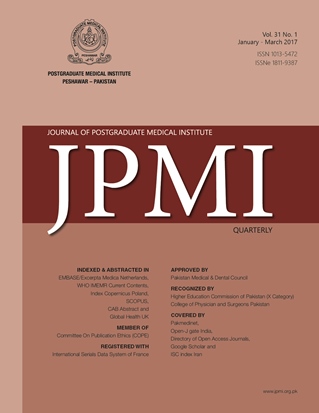A RANDOMIZED COMPARISON OF ULTRASOUND GUIDED VERSUS BLINDLY PLACED RADIAL ARTERIAL CATHETERS
Main Article Content
Abstract
Objective: To evaluate the effectiveness of ultrasound (US) guided radial artery
cannulation as compared to the blind insertion of arterial line in intensive care
unit of a tertiary care center.
Methodology: One hundred patients were divided into two equal groups. In
group I, arterial line was inserted using the blind palpation technique. While in
group II, arterial line was inserted with the help of ultrasound guidance. The primary
endpoints were time of insertion in 1st attempt, number of first successful
attempts and maximum number of attempts used for insertion of arterial line.
Data was analyzed by using SPSS V23. Chi-square test was used for analysis of
gender and successful insertion in 1st attempt. Independent sample t-test and
Mann-Whitney U-test were used to compare quantitative variables.
Results: Mean baseline systolic blood pressure, mean diastolic blood pressure
and mean pulse rate before surgery were also not significantly different between
the groups. Arterial line was inserted in first attempt in in 88.0% patients
in ultrasound guided group and in only 70.0% patients in blind palpation group
(p-value 0.027). Arterial line insertion time in 1st attempt was also significantly
less in ultrasound guided group 77.68±7.98 seconds versus 95.46±15.53 seconds
in blind palpation group (p-value <0.001). We also found less number
of attempts 1.16±0.37 in ultrasound guided group versus 1.44+0.67 in blind
palpation group (p-value 0.025).
Conclusion: Ultrasound guided radial artery cannulation is associated with
higher rate of successful insertion and less time is required for arterial line insertion
as compared to blind palpation method.
cannulation as compared to the blind insertion of arterial line in intensive care
unit of a tertiary care center.
Methodology: One hundred patients were divided into two equal groups. In
group I, arterial line was inserted using the blind palpation technique. While in
group II, arterial line was inserted with the help of ultrasound guidance. The primary
endpoints were time of insertion in 1st attempt, number of first successful
attempts and maximum number of attempts used for insertion of arterial line.
Data was analyzed by using SPSS V23. Chi-square test was used for analysis of
gender and successful insertion in 1st attempt. Independent sample t-test and
Mann-Whitney U-test were used to compare quantitative variables.
Results: Mean baseline systolic blood pressure, mean diastolic blood pressure
and mean pulse rate before surgery were also not significantly different between
the groups. Arterial line was inserted in first attempt in in 88.0% patients
in ultrasound guided group and in only 70.0% patients in blind palpation group
(p-value 0.027). Arterial line insertion time in 1st attempt was also significantly
less in ultrasound guided group 77.68±7.98 seconds versus 95.46±15.53 seconds
in blind palpation group (p-value <0.001). We also found less number
of attempts 1.16±0.37 in ultrasound guided group versus 1.44+0.67 in blind
palpation group (p-value 0.025).
Conclusion: Ultrasound guided radial artery cannulation is associated with
higher rate of successful insertion and less time is required for arterial line insertion
as compared to blind palpation method.
Article Details
How to Cite
1.
Ammar A, Ali L, Furqan A. A RANDOMIZED COMPARISON OF ULTRASOUND GUIDED VERSUS BLINDLY PLACED RADIAL ARTERIAL CATHETERS. J Postgrad Med Inst [Internet]. 2017 Feb. 13 [cited 2025 Dec. 13];31(1). Available from: https://jpmi.org.pk/index.php/jpmi/article/view/2043
Issue
Section
Original Article
Work published in JPMI is licensed under a
Creative Commons Attribution-NonCommercial 2.0 Generic License.
Authors are permitted and encouraged to post their work online (e.g., in institutional repositories or on their website) prior to and during the submission process, as it can lead to productive exchanges, as well as earlier and greater citation of published work.


